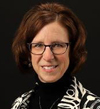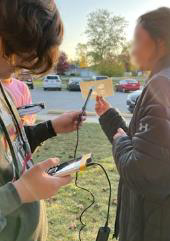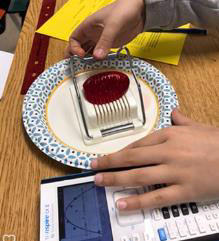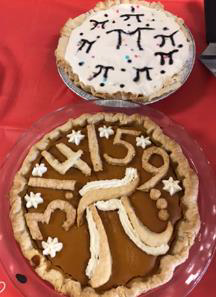December 20, 2022
 This is the fourth in a series of guest blogs by the 2022-23 Michigan Regional Teachers of the Year. Karen Sleno is a math teacher at Flushing Senior High School in Flushing Community Schools.
This is the fourth in a series of guest blogs by the 2022-23 Michigan Regional Teachers of the Year. Karen Sleno is a math teacher at Flushing Senior High School in Flushing Community Schools.
“So, what do you do for a living?”
“I’m a high school math teacher!”
“Really! Wow, I just never liked math. I had this teacher once …”
Little did I know when I decided to make math education my career that scenarios like the one above would become a regular part of my world. It is true that sometimes the response sounds much more positive than the one in that conversation, but all too often, a negative feeling toward math is what is projected.
But why? We never hear people proudly professing that they can’t read and just hated their English classes in school. Yet for some reason, the universal fear/dread of mathematics pervades our society. This realization has inspired not only a desire, but an obligation, to do something about it.
With that in mind, I would like to share three things I have implemented into my students’ classroom experience that will hopefully influence their mathematical outlook in a positive light for years to come.
1. Real-Life Explorations

Many people have shared with me that their memories of math class consist mainly of what was contained between the pages of a textbook. Is it any wonder then that their perspective is so dismal? Math is a beautiful subject filled with patterns, connections and endless real-life applications; I knew that students should experience this firsthand!
So, I make it a priority for my classes to see math all around them. For example, my precalculus class determines the effectiveness of various SPF levels of sunblock using our graphing calculators and UV probes that collect real-life data that is then analyzed to answer the question: Is an SPF 60 twice as good as an SPF 30? (The answer is no.)

Similarly, my AP calculus class calculates the number of licks to the center of a Tootsie Pop after three timed trials using their calculus skills (they feel smarter than the old owl!). Another lab they enjoy is finding the volume of a Jell-O egg using three different methods ranging from water displacement to the disk method. This sparks the discussion of why it may be necessary to find the volume of an object that cannot be submerged in water or may exist only in a design phase.
Finally, my Consumer Math students choose a career and a location where they’d like to live as adults, and then they find an apartment, choose a method of transportation and ultimately create a two-week budget that will pay the bills and hopefully allow them a bit of fun, as well. Every two weeks, it’s payday! But that’s not all. Students draw a paper from my basket to find out what else happened to them during those two weeks. Maybe their car broke down. Maybe they won at the casino. Maybe they got sick and had to go the ER. Those real-life occurrences are then wrapped into their next two-week budget, and sometimes they find the money just doesn’t go far enough!
2. Pi Day

In my classroom, March 14 is not just Einstein’s birthday (which it is); it is also the day we celebrate the number pi (3.14 …). All other learning is suspended for this day as we challenge each other to memorize as many digits of pi as possible while enjoying the creative presentations honoring pi that were prepared by the students.
From pi-focused rap songs to modified Shakespeare soliloquies to pi-centered puppet shows, this transcendental number is the focus of the day. And yes, we eat the delicious pies that students have made, too! Many students reach out in later years on Pi Day to share how much they miss the fun we had … yes, in math class!
3. Mu Alpha Theta (Math Honor Society)
Eighteen years ago, I realized that our school did not have a place for students who loved math to foster that interest. A bit of research led me to apply for a charter for Mu Alpha Theta, a national math honor society. Our group of students has now grown to near 80, and the enthusiasm for math is contagious. Each month, students plan and execute a meeting on a topic that interests them, whether it is a mathematician, a concept not learned in the traditional curriculum or another math-focused area.
Sometimes, guest speakers (often a former student) share their journey with math and how it led them to where they are today. Members proudly wear their student-designed math shirts and come out in full force to attend these meetings, where math is the beloved focus of the day. It’s inspiring!
I fully realize that one person can’t change the world, but if my small efforts lead my students to appreciate the power and beauty of mathematics a bit more, I will feel that I have accomplished something significant.
And maybe someday that response to “I’m a high school math teacher” will sound something like, “I love math! It's used everywhere! I remember I had this teacher once …” What a beautiful world that will be!